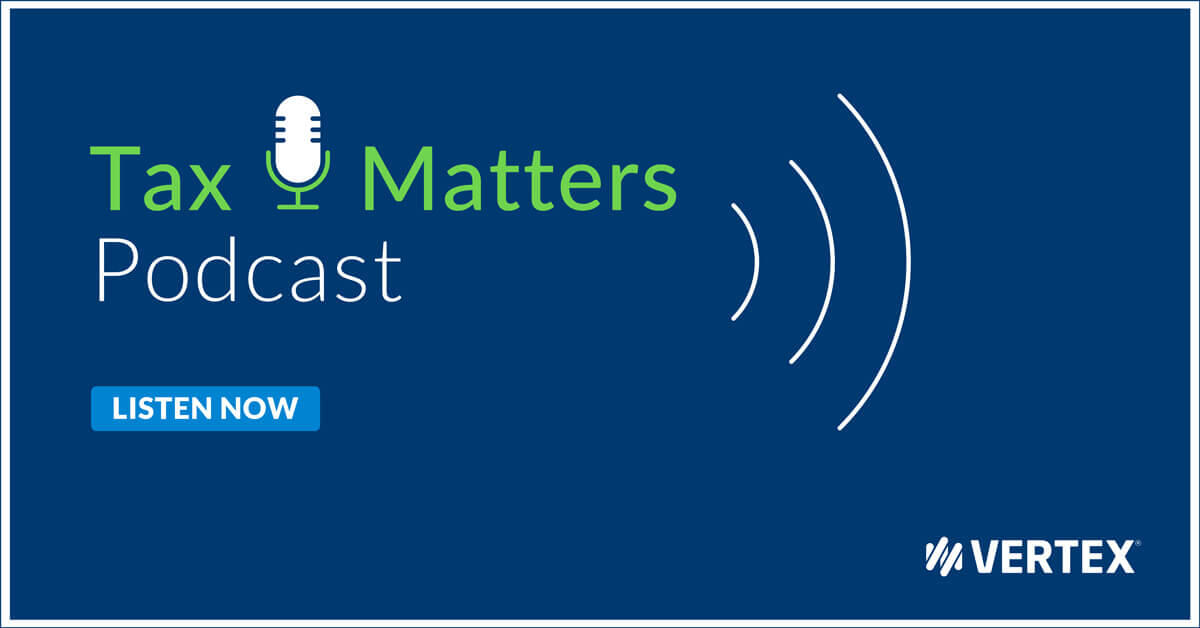Tricia Schafer-Petrecz: Welcome to Tax Matters, a Vertex podcast! I’m Tricia Schafer-Petrecz, External Communications Lead at Vertex.
In this episode, we feature new insights on cloud computing models from Forrester Vice President and Principal Analyst, George Lawrie.
George is a member of Forrester’s advanced manufacturing team. He researches supply chain and product lifecycle management platforms, as well as many aspects of cloud computing.
In this conversation with business writer Eric Krell, George talks about the benefits of cloud platforms along with the advantages of hybrid models that feature a blend of cloud and on-premise deployments. George also discusses how tax groups and other buyers can measure the returns on technology investments.
Now I’ll turn it over to George and Eric…
Eric Krell: George, it’s great to have you on Tax Matters. To get started, please fill us in on why organizations are investing in cloud computing today. At the highest level, what’s the value proposition?
George Lawrie: Well, thanks for having me, and it’s great to talk to you and to your listeners. I think to compete in the digital economy, Forrester readers and our clients see that moving to the cloud will help them boost agility, help them to scale their applications, and add to their insights that support new business cases. Cloud computing releases the enterprise from needing to acquire and manage infrastructure. You know how it is: you’ve always got too much or too little. You might not be able to accommodate all the users that you have, or you might be paying for infrastructure that you’re not using just because you haven’t scaled up yet. The great thing about moving to the cloud is that you can pay for just the amount of shared storage network and computing capacity that you need, instead of having this problem of spare capacity. I also think that it’s really hard to forecast your transaction and your analytic load in the digital economy because you often have people who are not in your company using your applications. They’re coming onto your website and buying from you, as an example.
Eric Krell: Forrester conducts research on many facets of cloud computing and other deployment options. What does your research tell us about the benefits of cloud investments?
George Lawrie: People in the past used to think about it as being cost, but it’s business agility. And actually, interestingly, it’s resiliency as well. So, you don’t have to manage your recovery, somebody else is managing it for you. There are others as well, so people think about speed and innovation, which are necessary to be competitive -- or these days even just to stay afloat. So, one of the things that they think about is: If we move to software-as-a-service, we get innovation more quickly and we don’t have to worry about it so much.
Eric Krell: Agility and resilience have been absolutely crucial in the past two years and now look all but assured to remain vital. What are one or two specific ways that the cloud model enables or improves organizational agility?
George Lawrie: I’d say, there’s a couple really. Faster deployment and development, so you can cut your deployment times. Lots of deployments can take under a year even for very large ERP applications, whereas the on-premises deployments took two or three years, sometimes longer. Why is it that much faster? Because you don’t have to procure hardware, you don’t have to do so much testing, or install software. Besides faster deployment, you get faster development – you can extend applications, or the vendor can develop them, much quicker than you could when you’re doing it on-premise. And that would be much harder to do on your own. That would be much easier when you’re sharing that development effort across other people that are using the same software as a service.
Eric Krell: Great, and are there any other ways that cloud computing helps organizations enhance agility and resilience?
George Lawrie: That’s a good question. I’d say things like more sharing and more collaboration are powered by that single version. So, the idea of having lots of users on a single version, it does help to share best practices and it speeds time to value. Plugging into the collective buying power, for example, of a network, lets customers get immediate benefits. They get savings by understanding what the whole network sees as best practice, but sometimes regarding things like reputation as well. So, what’s the reputation, or what’s the master data, that relates to an item and particularly for tax. And think about carbon taxes: If we all share the same system, we might know about a supplier’s practices, their carbon footprint, but we might also know about [a particular] item. So, this item that we’re all working with -- which tax category does it fall into for green taxes?
Eric Krell: Your research shows that on-premise deployments of business systems also deliver benefits, what are some of those advantages?
George Lawrie: An on-premise development offers a higher degree of independence. You never have to worry about recovering your data. If you quarrel with the cloud service provider, we’ve had people talk about this a lot, they really worry about, “If I fall out with my software-as-a-service provider, how will I get my data back?” You can also choose when to upgrade or you can even customize your apps to your heart’s content. But of course, you need people, and you need the expertise on your payroll to do that. On-premise deployments also protect against cloud round-trip latency... If you have a very high-volume process -- perhaps point-of-sale scanning and settlement, warehouse-picking, or manufacturing operations management – well, those could be vulnerable to resource congestion in your wide area network. With on-premise deployment, you can throttle each application’s consumption of resources to meet your own priorities.
Eric Krell: Are there situations in which organizations should consider having both models in place, like a hybrid or a blend of on-premise and cloud computing?
George Lawrie: I’d say that’s absolutely the case. So, enterprises choose their deployment based on specific use cases and the evolution of specific applications. For low-touch, high-transaction volume retailing, a company might, for example, deploy on-premise. But for a highly personalized lower volume retailing – which involves orchestrating lots of enterprise services such as inventory availability, or reviews and recommendations, or maybe some personalization -- you might choose cloud deployment then.
Eric Krell: Forrester has a total economic impact, or TEI, model to help companies measure the returns on their software investments. If you would, highlight for us how that model works and what its primary deployment options are?
George Lawrie: So, the TEI model: you can download it, and you can customize it yourself. One of the things that we do periodically for companies is that we interview their users and find out what it cost them to implement this new technology, and then, what was the value that they got out of it? Normally, when we’ve done that, we create something that we publish and that our users can get access and they can customize it themselves. With TEI, we have the ability for organizations to look at the relative value of building vs. migrating, vs. modernizing their applications and – finally – vs. replacing them with software-as-a-service. Each of those are elements in the TEI, so you can look at the relative cost and the relative value that people, based on our interviews, claim to get from those.
Eric Krell: George, are there any risks or downsides to keeping both models working at once -- both on-premise and cloud?
George Lawrie: That’s a good question. The main challenge is to synchronize the application functionality and data. For example, how do you ensure that your on-premise tax tables -- I’ll just take that as an example -- and processing match those of the more easily updated cloud version? Conversely, for cloud deployment, how do you factor in location specifics? So, I move my mobile point of sale across the street, for example, now it’s in a different tax jurisdiction. So, you have to think about how you would manage that.
Eric Krell: Thanks very much for sharing your time and insights today. Do you have any parting suggestions for how a company, or a project team can evaluate which technology model, or which blend, is best for their current and future needs?
George Lawrie: Thanks Eric. I’m going to put in a shameless plug here, and say that perhaps your listeners would like to look at the Forrester Total Economic Impact research and use the interactive model themselves to see what kind of guidance that provides about the business case for each approach -- which use cases ought to be in the cloud and which ought to be on-premise.
Tricia Schafer-Petrecz: Thank you for listening to Tax Matters, a Vertex podcast…Check back here for more episodes soon.


